more explicit about this step and include Reinforcement as one of
their phases. I've also read this final step of freezing referred to
as the lock-in effect. Establishing stability only happens when the
new changes are locked-in.
Thinking about change as a journey might make you think that a
journey has a beginning , middle, and an end. While this is useful
when thinking about the process of change the reality is that this
journey doesn't have an end. Lots of rest stops maybe! Some
opportunities for settling down for a while. But no end. So be
936
careful about thinking that a change process has a definite end,
as the Lewin change management model might seem to suggest.
In what ways do you think this model might be useful for you?
I've found the Kurt Lewin model useful to frame a process of
change for people that is quite easy to understand. Of course
each stage can be expanded to aid better understanding of the
process. Applying the concepts of Unfreezing, and especially the
Force Field Analysis, at a personal level can give us insight and
help us better understand how we deal with change.
Force Field Analysis - Kurt Lewin
Kurt Lewin's Force Field Analysis is a powerful strategic tool
used to understand what's needed for change in both corporate
and personal environments. Best of all - it's easy to use and has
complete credibility as a professional tool.
We'll use a little basic science to introduce the concept, after
which you'll find enough information to allow you to unleash
your knowledge of force fields on colleagues!
The concept
Let's start with a simple science experiment (this really is
relevant, so stay with me for a moment please).
You'll need to sit down for this one. You're sitting? Good. Now,
what's keeping you in the chair?
Well, there are two answers really. One is gravity which is
pushing you down into the chair. A driving force, if you like.
The other is the chair itself, which provides an opposing force,
pushing up against gravity, and stopping you falling to the
ground.
937
So it would seem that while you are sitting you're in an
equilibrium of sorts.
Two forces keep you there. Gravity pushes down, keeping you in
the chair, and the chair resists this, stopping you from falling to
the ground.
Two equal forces, a driving force and a resisting or restraining
force, working to keep the equilibrium or status quo.
Agreed? Okay, now let's play. Let's say we want to move away
from this equilibrium and get you to fall to the floor. What could
we do?
Well, on the one hand we could increase the amount of gravity.
The chair will give way eventually and you will fall.
On the other hand, we could leave gravity alone and decide to
weaken the chair to get the same result.
If you've followed me this far then you've just completed a force
field analysis and understood the basic concepts of the force field
analysis. It also helps to explain why our science experiment is
relevant.
You see, Kurt Lewin applied exactly this thinking to his theory of
change within social situations - to people.
May the Force be with you, or against you.
Kurt Lewin wrote that "An issue is held in balance by the
interaction of two opposing sets of forces - those seeking to
promote change (driving forces) and those attempting to
maintain the status quo (restraining forces)". This is much the
same as the experiment we just did and is summarised in the
diagram below.
938
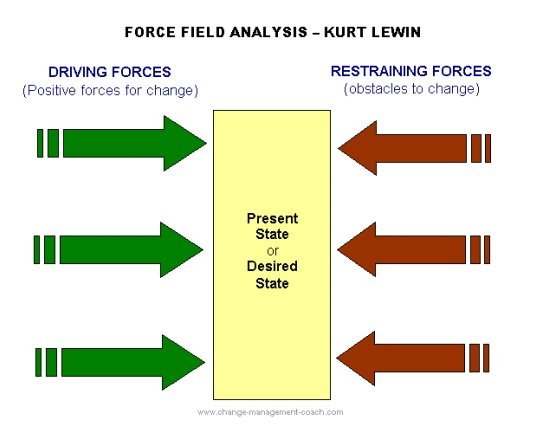
So before change the force field is in equilibrium between forces
favourable to change and those resisting it. Lewin spoke about
the existence of a quasi-stationary social equilibrium.
For change to happen the status quo, or equilibrium must be
upset – either by adding conditions favourable to the change or
by reducing resisting forces.
What Kurt Lewin proposes is that whenever driving forces are
stronger than restraining forces, the status quo or equilibrium
will change.
Now that's useful. Especially if we apply this to understanding
how people move through change and why they resist change.
There will always be driving forces that make change attractive
to people, and restraining forces that work to keep things as they
are.
939
Successful change is achieved by either strengthening the driving
forces or weakening the restraining forces.
The force field analysis integrates with Lewin’s three stage
theory of change as you work towards unfreezing the existing
equilibrium, moving towards the desired change, and then
freezing the change at the new level so that a new equilibrum
exists that resists further change.
Using the Force Field Analysis
Lewin's force field analysis is used to distinguish which factors
within a situation or organisation drive a person towards or
away from a desired state, and which oppose the driving forces.
These can be analysed in order to inform decisions that will
make change more acceptable.
'Forces' are more than attitudes to change. Kurt Lewin was
aware that there is a lot of emotion underlying people's attitude
to change.
To understand what makes people resist or accept change we
need to understand the values and experiences of that person or
group.
Developing self awareness and emotional intelligence can help to
understand these forces that work within us and others. It’s the
behaviour of others that will alert you to the presence of driving
and restraining forces at work.
The following steps are a guide to using the force field analysis.
You might find it useful to follow the process using the Force
Field Analysis Application Tool available .
1. Define the change you want to see. Write down the goal or
vision of a future desired state. Or you might prefer to
understand the present status quo or equilibrium.
940
2. Brainstorm or Mind Map the Driving Forces - those that are
favourable to change. Record these on a force field diagram.
3. Brainstorm or Mind Map the Restraining Forces - those that
are unfavourable to, or oppose change. Record these on the
force field diagram.
4. Evaluate the Driving and Restraining forces. You can do this
by rating each force, from 1 (weak) to 5 (strong), and total
each side. Or you can leave the numbers out completely and
focus holistically on the impact each has.
5. Review the forces. Decide which of the forces have some
flexibility for change or which can be influenced.
6. Strategise! Create a strategy to strengthen the driving forces
or weaken the restraining forces, or both.
If you've rated each force how can you raise the scores of the
Driving Forces or lower the scores of the Restraining Forces, or
both?
7. Prioritise action steps. What action steps can you take that
will achieve the greatest impact? Identify the resources you
will need and decide how to implement the action steps.
Hint: Sometimes it's easier to reduce the impact of restraining
forces than it is to strengthen driving forces.
Criticism of the force field analysis usually focuses on the
subjectivity of attributing scores to the driving or restraining
forces.
Some writers suggest the model applies within limited settings
and that there are situations outside of these settings in which
Lewin’s theory may be less applicable.
At the end of the day the force field analysis is a tool that may or
may not be useful in your situation. You can decide this or allow
others to make a decision.
941

The force field analysis is backed by the Lewin change
management model and has, over time, developed credibility as
a professional change management tool
Sources:
http://www.alancohen.com/coachtraining/life-coach-training-
lesson-18/
"Unleashing Potential – The Promise of Coaching"
Yvonne Freitas McGookin & Matt Aspin
http://www.change-management-coach.com/resistance-to-
change.html
http://www.change-management-coach.com/kurt_lewin.html
942
4.3 EFFECTIVE GOAL SETTING
A study revealed that amongst people with the same
background, the top three percent outperform the next twenty-
seven percent by a factor of ten. One of very few differences
between these two groups was their attitude to goal setting.
The top three percent have clear, written goals. For the twenty-
seven percent group to join the top group would only take a shift
in some attitudes and a realization that the art of goal setting
would make them more successful to an amazing degree.
In order to be effective, goal setting should be :
-
consistent with the coachee’s stage of change’ (e.g. a ‘pre-
contemplator’ may resist a goal of total abstinence, but
mayembrace reducing the risk of infection)
-
negotiated. Negotiation is not bestowed on a coachee . It is a
strategy to influence behaviour. Negotiated goals are more
likely to generate patient commitment and adherence.
-
realistic
-
specific and achievable. A broad goal may be broken down
into several component parts
-
short-term; so that progress can be monitored and success
quickly realised
- solution-focused and defined in positive terms. Changing
behaviour will be more successful if couched in positive
terms of acquisition, rather than reduction; presence, not
absence (e.g. increasing the number of days without smoking
as opposed to decreasing the number of smoking days)
943
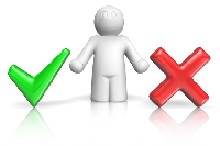
FIVE EASY STEPS TO SMART GOAL SETTING
In order to have a good chance of being accomplished, a goal has
to be specific.
The point is, you need to know HOW TO SET SMART GOALS if
you want to make SMART decisions in your life.
Developing the skill of smart goal setting has the potential to
make a significant difference in your life - it provides a solid
platform for:
Starting personal and business projects
Making strategic decisions
Creating excellent action plans which incorporate your
short and long term development goals
If you don't know how to set SMART GOALS, then you may well
not be realizing your full potential.
Any SMART person will tell you the
same thing: “if you don't know where
it is you want to go, you are going to
wind up somewhere else!”
This would be so sorry, because you
don't want to invest your precious
time into any adventures without
knowing exactly what it is you want
to achieve, both in the short and long term.
A lot of people go into a venture, having some vague idea about
what they want to achieve and where they want to be in 6
months, 1 year, 5 and 10 years down the track. Well, I'm here to
tell you that unless those ideas can be translated into specific
944
and measurable SMART GOALS, they are wasting their time -
they just ain't gonna get there………sorry!
WRITE YOUR GOALS DOWN - Think about your DREAMS and
aspirations - where do you see yourself down the track, what are
you doing, who are you doing it with, who do you want to help,
do you own the house of your dreams, the car of your dreams,
are you traveling the world, etc, - You get the picture………!
The problem is that the words GOALS and DREAMS all too often
become synonymous and that is where confusion sets in!
Of course, there is nothing wrong with having a vision for your
business and your life,. In fact it is absolutely a key ingredient for
success.
However, if you think a goal looks like this: "I would like to be
financially free, able to give up my JOB, stay at home and
look after my kids, take them on world trips and live in a
million dollar house"
Then think again!!!
That's a dream alright,
the kind you have in your pillow at night!
But it's NOT a Goal!
Sure, it could be your vision and it could become your reality, but
in order to achieve this wildly inspiring picture you need to
immerse yourself in some "real" goal setting activity, not just
dreams!
945
So let's cut to the chase!
What is SMART goal setting?
S M A R T is a mnemonic used in management.
S M A R T is a way to evaluate that the objectives for a particular
project are relevant and appropriate for that project.
S M A R T Objectives are an integral part of Management By
Objectives (MBO). Management by objectives has been used
extensively by managers as a planning tool. It is a process by
which managers and employees work together and agree on
specific and defined objectives for a particular project. This
process ensures that both managers and employees agree on and
are committed to the project outcomes.
The origin of the term S M A R T objectives is unknown, however,
Peter Drucker in his 1954 book "The Practice of Management"
outlined a system that was very similar to S M A R T objectives as
part of his discussion on Management by Objectives (MBO).
The process of writing S M A R T objectives or smart goal setting
has become a business management tool used extensively for
project management and also for performance appraisal
purposes.
Learning how to write and use SMART goal setting is a skill you
definitely want to master
if you want to be successful in YOUR life and in YOUR business!
946

Success does not just happen to the
lucky, nor is working hard sufficient. It
is all about developing skills for success
and those skills are many and varied.
If you really want to make your life
hum, you'll develop the skill of SMART
goal setting and include this process as
an integral part of your action plan.
Smart goal setting adds clarity, focus and purpose to every action
plan.
Without objectives, planning is often non existent or at best done
at the same time that you are about to take action! This is
problematic and not good practice. Plans can often change as a
result of either a lack of time to consider all options or because
there was no predetermined outcome in the first place. In other
words, you are flying by the seat of your pants instead of having
a well thought through plan of attack.
So what do you do if you've got NO IDEA how to set goals for
your life and you need some goal setting tips - some simple
techniques to get started?
Well, I've got GREAT NEWS for you!
It is really not that complex if you follow………
The 5 Easy Steps to SMART goal setting!
Before we get started on those 5 Easy Steps, I want to make sure
you are 100% clear on the following:
947
Firstly, what is an objective or goal?
An objective or goal is a specific statement describing a RESULT.
Secondly, why set goals?
Setting and clarifying goals is an essential part of the path to
success.
Thirdly - what do objectives or goals provide for YOU?
Direction for activities
A clear process for defining expected results
The criteria against which actual accomplishments can
be measured
Targets to motivate performance improvements
A common sense of purpose, which enhances teamwork
SMART goal setting is one of the most positive and rewarding
habits you can develop in your personal life, as it is in any
business. It is a process by which you can evaluate the current
situation and develop strategies to move forward. Moving
forward is what gives you the growth and success that most
people aspire too.
If it is your desire to be successful in your life, then you most
certainly don't want to accept the "status quo". The only way to
make sure you are not sitting in exactly the same place you are
sitting in today, in 6 months, 1 year or 10 years time is to
implement smart goal setting as one of your primary practices.
SMART Goal Setting assists YOU to PLAN AHEAD
and develop a STRATEGIC APPROACH
to creating SUCCESS inYOUR life!
948
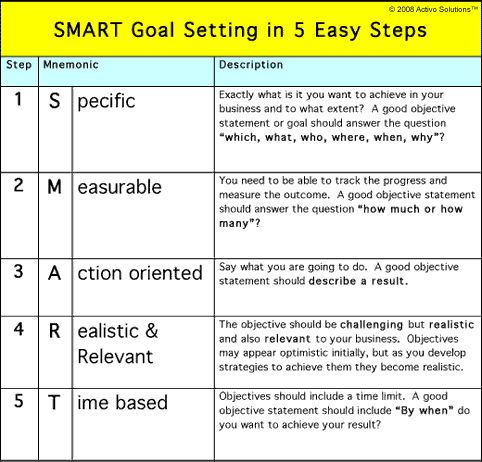
Here is how you do it:
OK, so that's the goal setting theory - how would you apply this S
M A R T model to your life?
If a goal or objective is going to be an effective success building
tool it needs to be S M A R T. In other words you need to write
your goals so that they measure up against the S M A R T criteria
from the 5 Easy Steps chart above.
949
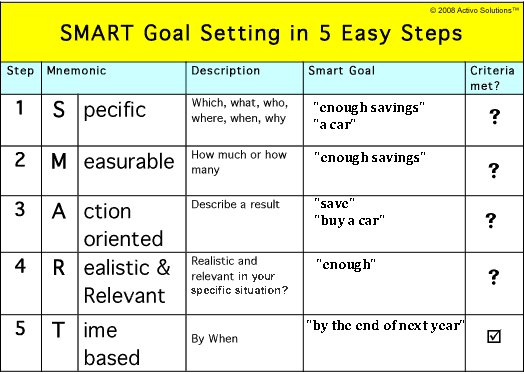
Let's take a look at a real life example.
How about this:
** "I want to save enough in order to be able to buy a new car by
the end of next year.” **
Is this a SMART Goal - does it measure up?
Let's break up this goal and see if it's SMART using the goal
setting form below.
Can we can tick all the boxes right?
It doesn’t really look like this could be an excellent example of
smart goal setting, does it?
950
Let's look at this more closely by evaluating this objective in
terms of each of the 5 Easy Steps:
STEP ONE - SPECIFIC - is this objective specific?
Do we know WHAT we are looking at here? NO, we do not - our
objective is too vague: we do not know how much we will have
to save, nor what car we want to buy.
Vague objectives are not inspiring. We have to be able to
visualize our goal: see ourselves enjoying the success when the
goal will be met.
STEP TWO - MEASURABLE - Do we know HOW MUCH or HOW
MANY?
You may have a perfectly clear idea about the price of the car you
want to buy and the amount of money you will have to save, but
you omitted to write the numbers down. In three months from
now, how will you know that you are on the good track? How
will you know when an extra effort is required?
STEP THREE - ACTION ORIENTATED - Does it describe a result?
Again, the words "save" and “buy a car” are too vague I'm afraid.
What do they really represent? How would you measure this?
How could you know that you are actually saving enough? Can
you find a better way to describe the result you are looking for?
STEP FOUR - REALISTIC - Is this goal realistic and relevant to the
business owner?
Again, it doesn’t show from the description of your goal. How
much are you earning? How much can you save? How will you
spread your saving effort? How will you anticipate possible
changes in earnings, expenses, price of the car, unexpected costs,
…? In a smart goal you will have taken these elements into
account,
951
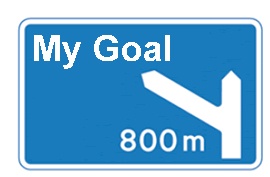
The key to remember here is this: smart goal setting is about
setting goals that are challenging but realistically achievable - no
point setting a goal for the sake of it and knowing there isn't a
hope that you'll ever achieve it - that would be pretty
demoralizing, not to mention slightly stupid!
STEP FIVE - TIME-BASED - BY WHEN should this be done?
In this case do we have a deadline by which this goal should be
achieved in order that we might measure the outcome? The
short answer is YES, we do.
So, in this example, out of the 5 steps, only one has been
correctly defined. How helpful would it be to you if your goals
are this vague? - Is this SMART goal setting? ----- Well, NO!
The solution to better planning is to
define challenging, but realistic goals,
then think ahead about what, how and by
when exactly you want to achieve, be very
specific about your data ... and to plan
regular evaluations.
The "5 EASY STEPS TO SMART GOAL SETTING".
Smart Goal Setting is a very important part of your skill
development and overall success in life. Don't ever
underestimate the power of this skill to make your life hum!
LEARN it, PRACTICE it and APPLY it to YOUR life.
You'll be very glad you did!
Source: http://www.network-marketing-mlm-success-
system.com/smart-goal-setting.html
952
Goals and Goal-Setting
Goal-setting is the one activity that sets apart self-developers
from those who survive or just get by. Goal-setting enables us to
create the future we want to happen rather than live the future
that others want to happen. In goal-setting, we take charge. Here
are 7 ways to set reachable goals.
1. Start With Your Strengths
Although you can base your goals on anything you want, your
chances of success are greater if, first, you base them on your
strengths and second, on the current opportunities in your field.
To find out your strengths, do some self-research, such as a
personal SWOT: your strengths, weaknesses, opportunities and
threats.
2. Put Your Goals In Writing
Written goals have a way of transforming wishes into wants,
can'ts into cans, dreams into plans and plans into reality. The act
of writing clarifies your goals and provides you with a way to
check your progress. You can even add reasons to give you more
motivation. So don't just think it - ink it!
3. Dream Big
One of the factors










